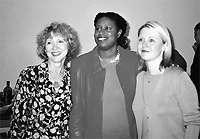|
Club and faith groups partner to curb global warming, stop sprawl
By Sarah W. Heim-Jonson
Last spring, a group of volunteer lobbyists turned more than a few heads as they walked through the halls of Congress. Brother Jacek Orzechowski, a Franciscan monk draped in brown robes, and Dr. Barak Gale, a Jewish Sierra Club leader wearing his yarmulke, weren't meeting with legislators to discuss funding for religious programs - they were there to support an end to logging on federal lands.
"Legislators are used to hearing Sierra Club members lobby on these issues, but bringing in the faith community changes how people see the issue," says Anne Woiwode, director of the Mackinac Chapter, which works with church groups on sprawl issues. "It's amazing how changing the messenger can change how the message is received."
 |
Father Charles Morris offers a blessing of the newly installed solar panels and wind turbine at St. Elizabeth's Catholic Church in Wyandotte, Mich. |
There was a time, however, when the messengers might not have found their way.
 Connie Hanson, a Presbyterian who walked the halls with Orzechowski and Gale, is a Club leader on the national End Commercial Logging on Federal Lands Campaign Committee. She remembers the years when she felt her Sierra Club interests had to remain separate from her faith beliefs, even though she wanted them to blend. Connie Hanson, a Presbyterian who walked the halls with Orzechowski and Gale, is a Club leader on the national End Commercial Logging on Federal Lands Campaign Committee. She remembers the years when she felt her Sierra Club interests had to remain separate from her faith beliefs, even though she wanted them to blend.
"I used to feel like I had to wear either my Club hat or my church hat," says Hanson.
Now, she is active as a Christian environmentalist, working with the Sierra Club, the Religious Campaign for Forest Conservation and her own organization, Christians Caring for Creation.
Carl Pope, executive director of the Sierra Club, has been watching the migration of religious groups into the environmental arena with increasing interest, and has urged his colleagues to pay attention.
"It is a mistake to think of the environmental and religious communities as mutually exclusive," says Pope. "There are millions of people who are in both."
In fact, thousands of people are active in coalitions of interfaith religious and environmental groups - fighting sprawl in Detroit, promoting renewable energy in nearby Wyandotte and protecting watersheds in Maine.
In Detroit, the Sierra Club and local churches have been working together to stop sprawl and increase mass transportation around the metropolitan area.
The Detroit area loses 13 square miles per year to sprawl and its public transportation is among the worst in the country. For the 1 million inner-city dwellers, one-third of whom don't own cars, that means trouble.
The Club's Southeast Michigan Group first teamed up with the Metropolitan Organizing Strategy Enabling Strength (MOSES) in 1999. MOSES was founded by Catholic activists, but has been joined by Presbyterian, Anglican and Baptist churches.
"The city is heavily Catholic, as is the group. Because of that, the partnership between the Club and MOSES is an effective one," says Bob Duda, chair of the Southeast Michigan Group.
Duda says the coalition is making progress. "We are now getting at least lip service from area officials who say they are interested in mass transit - that is a huge improvement over where we started."
A different kind of coalition has formed in the watersheds of the Northeast where environmental activists and people of faith come together around a shared interest in eco-spirituality - regardless of religious belief.
Since 1998, the Maine Chapter of the Sierra Club and the Maine Council of Churches have worked as partners in the Spirituality and Earth Stewardship program, focusing on watershed and global warming issues. The program educates members on the science behind the issues and shows them how to help protect watersheds and stop global warming.
Susan Sargent, a grassroots organizer and vice chair of the Maine Chapter, laughs as she describes the beginning of a partnership between her chapter and the Maine Council of Churches. "Since I'm an activist and organizer, I have at the top of my to-do list: find a coalition. But it's become so much more than that."
"Our meetings are celebrations held in a different watershed each season," she explains. "All these environmentalists get together and talk about what's happening in their watershed and perform rituals at the same time. There's a Celtic harpist who plays nature and spiritual songs. It's a far cry from a regular meeting."
In addition to these quarterly meetings, the coalition runs a grant-funded program called "Women's Voice in the Environment," which organizes hikes, environmental policy education, eco-spirit workshops and lobbying trips.
Sargent says, "Rarely in the middle of a campaign do you get a chance to just stop and contemplate what's happening. This partnership offers us all a chance to reflect on the bigger picture."
Father Charles Morris recently saw the bigger picture from the rooftop of his church, St. Elizabeth's in Wyandotte, Mich. Morris, a priest and Club member, conducted a dedication and prayer ceremony for the installation of solar panels and a wind turbine.
With the help of the Interfaith Global Warming Task Force (a project of the National Council of Churches and the Council on the Environment and Jewish Life), church leaders like Father Morris are becoming more engaged in efforts to curtail global warming.
"I think if we can do this retrofitting in Wyandotte, a working-class neighborhood in an industrial metropolitan area, others can do it almost anywhere," says Morris.
Pam Frucci, a member of the Mackinac Chapter and Interfaith Global Warming Task Force, who attended the ceremony, said it appeared that the retrofit was working.
"On the day of the blessing, the PA system was powered by the solar panels," she said.
Photo at top courtesy Kim Winchell
Up to Top
|